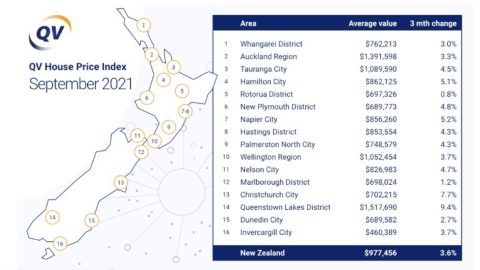The low growth residential mortgage market has created a new phenomenon with banks now prepared to cough up break fees to help win business from customers on fixed-term loans with rival banks.
(feel free to discuss any of the topics in this article with a free chat – contact us HERE)
One mortgage broker with over a decade’s experience says such action is currently pretty widespread and isn’t something she has seen before.
One example she cited saw a bank stump up $7000 to cover break fees in order to win a $300,000 mortgage off another bank.
Meanwhile, an interest.co.nz reader said he had seen deals where Westpac’s paying “upwards of $5000” of break fees, suggesting banks being prepared to pay break fees had changed the market dynamic because customers became fully mobile between banks. “From what I see Westpac and ANZ National are most aggressive in paying break fees to get new clients and ASB least.”
Existing customers are also benefiting by threatening to take their business elsewhere. Another reader said: “We bank with BNZ and went to Kiwibank to see what they could do for us.
Kiwibank offered to pay our break fees, legal costs and the lower (interest) rates. We then asked what their maximum discount could be and their offer was better than expected. We took that back to BNZ who offered to match Kiwibank. They didn’t charge a break fee.”
Break fees, or early repayment costs to the banks, come when a fixed rate loan is repaid early. The lender may seek to recover money it’s losing out on through the early repayment by charging an early repayment fee.
Generally speaking, a lender will lose money if interest rates at the time of early repayment are lower than the interest rate applicable to the loan. This is because the lender cannot re-lend the repaid funds at the same rate that it could when it first loaned the money.
These break fees vary from loan to loan but can amount to thousands of dollars. See more on them here from the Banking Ombudsman.
On top of banks paying up for break fees, they’re also being more generous than in the past in terms of contributing towards the likes of customers’ legal and valuation fees.
Interest.co.nz has been told of banks contributing up to $4500 towards the likes of legal fees, valuation fees and insurance for new customers, with the mortgage broker with over 10 years experience describing this as “nuts”, because in some cases it allows customers to pocket cash with their costs more than covered.
On top of this she said banks were knocking up to 60 basis points off advertised mortgage rates.
‘Incredibly aggressive, unsustainable market’
Squirrel Mortgages principal John Bolton said banks paying break fees to win customers over from other banks is something that never used to happen. He said it was a symptom of a low growth environment and cashed up banks driving an “incredibly aggressive” market, but argued it was not sustainable.
Bolton said from the banks’ perspective it was okay when it was not that widespread.
“But when it becomes a core cost to your business, they’re just actively destroying the profitability of their portfolio,” said Bolton.
“If you look at it in totality, you’re in a low interest rate environment, which means generally speaking the margin on your (the bank’s) liability product is going to be a lot smaller. To date that has been compensated by bigger margins on their lending books but as those margins get competed down in a no growth environment, where do you go?
“I think in reality, when markets go from being growth to no growth, you end up with a bit of a blood fight until things settle down. And once people’s profitability starts to get hammered, you start to see them being a bit more cautious,” Bolton suggested.
Shaun Riley, CEO of Mike Pero Mortgages, said in his experience banks did not usually pay all of the break fee, rather a contribution to “soften the blow” for premium clients who borrow significant sums, usually the beneficiaries.
Cashed up banks
The big four Australian owned banks – ANZ NZ, ASB, BNZ and Westpac NZ – have all delivered record half-year cash earnings in their current financial years. Combined, their half-year earnings came in at $1.705 billion, up $393 million, or almost 30 per cent, from $1.313 billion in the first-halves of their previous financial years.
And Kiwibank is heading for record annual profit, with its profit for the first nine months of its current financial year just $2.6 million below the bank’s previous record annual profit of $63.6 million in the year to June 30, 2009.
The banks’ bottom lines have been bolstered by customers switching to floating, or variable, rate mortgages from fixed-term ones over the past couple of years. Banks do better out of floating mortgages because the margin between the variable rate and short end of the yield curve, such as three month bank bills, is higher than the margin between the swap rate and fixed rate mortgages.
The overall percentage of total mortgages by value on floating interest rates has this year reached its highest point since the Reserve Bank began keeping records on fixed versus floating in June 1998. The latest data shows 63 per cent, or $108.8 billion, of the total $172.6 billion mortgages were floating at the end of April.
Despite the increased number of more profitable floating mortgages on their books, the banks do like a decent chunk of fixed-term mortgages because it gives them more certainty and customers with floating mortgages don’t have to pay break fees when they leave, meaning traditionally it has been easier for them to do so.
Weak lending growth, but lots of mortgage approvals as first home buyers tap KiwiSaver
Meanwhile, Reserve Bank sector credit data shows a total of $174.590 billion of housing debt at the end April. That was up just 1.4 per cent year-on-year versus double digit growth between 2003 and 2008.
In contrast the Reserve Bank’s weekly mortgage approvals data, which includes banks refinancing other banks’ customers, shows more than $1 billion worth of approvals in 16 of the last 17 weeks (with Easter week the exception), the type of run not seen since 2007.
The Real Estate Institute of New Zealand (REINZ) yesterday said 7175 properties were sold nationally in May, up 26.4 per cent from April and up 24.4 per cent from May a year ago.
Auckland’s median price rose 7.8 per cent in May from a year ago to a record high $500,000, while 2792 properties were sold in the City of Sails, up 28 per cent from a year ago.
The national median house price rose $4000 to $369,000 in May, just $1000 below the record high reached in March.
And the national REINZ Stratified House Price index, which adjusts for some of the variations in the mix that can impact on the median price, is now 0.3 per cent higher than the previous market peak in November 2007.
Riley said a noticeable increase in enquiries from first home buyers was a recent feature of the market, with many helped by money saved through KiwiSaver.
“We’re doing a fair number of deals where part of the deposit has come from KiwiSaver,” said Riley. “That has helped especially in that first home buyers market. If you’ve got a couple, both in KiwiSaver, they can get three or four grand each from the first home buyer subsidy, plus they can withdraw their contributions. Often it’s 10 to 15 grand towards a deposit of maybe 30 grand. That’s helping stimulate the market a little bit.”
What do the banks themselves say about paying break fees?
Glenn Patrick, BNZ’s chief operating officer of retail banking, said BNZ did not pay break fees in order to win over other banks’ customers.
“Our total banking offering is compelling and competitive and we’re continuing to attract good levels of new business,” Patrick said, highlighting BNZ’s TotalMoney mortgage product, which allows borrowers to offset their home loans against savings.
“We’re backing ourselves to provide an overall package of products, services and exemplary customer service that customers will want to take advantage of for the long-term,” said Patrick.
“There are some costs we’re happy to help with such as a contribution to legal fees and waiving some bank fees. This is considered on a case by case basis and is based on the value of the total relationship we have with the customer.”
Kiwibank spokesman Bruce Thompson said the state owned bank would make a commercial assessment of how much, if anything, it was prepared to contribute to a new customer’s costs – including valuations, legal costs and in some cases break fee costs – in order for them to be able to switch to Kiwibank.
“Ultimately it’s a commercial decision as to if we contribute X towards this customer coming to Kiwibank is that commercially viable, and will we ultimately benefit from that customer being here?” said Thompson.
ASB’s executive general manager for retail and business banking Ian Park said: “Break fees are charged to recover the real costs that may be incurred by the Bank when a customer opts to exit their home loan fixed rate contract early.
We assess every customer’s home lending application on a case-by-case basis, and we may assist customers with some professional fees or bank fees. ASB does not have a policy of paying break fees.”
An ANZ NZ spokesman said: “It has been standard practice for many years to consider assistance to customers who wish to transfer their mortgage to us. The amount involved depends on a range of factors. The number of transfers tends to increase as the number of new mortgages increases.”
And a Westpac spokesman said: “We are aware of the type of behaviour you are referring to in the market, but we do not have a policy of paying break fees.”
By Gareth Vaughan of interest.co.nz (article written 2012)
Need to discuss any of the ideas in this article? Contact us HERE
.
Some of our handy pages and links:
► Refinance / remortgage: https://www.smartbrokers.co.nz/should-i-remortgage-in-new-zealand/
► Mortgage Reviews NZ: https://www.smartbrokers.co.nz/why-should-you-have-a-mortgage-review/
► How to repay your mortgage in 10 years: https://go.smartbrokers.co.nz/smart-dbc-live-edited-on-demand/
► Mortgage Calculator: https://www.smartbrokers.co.nz/nz-home-loans/mortgage-repayment-calculator/





